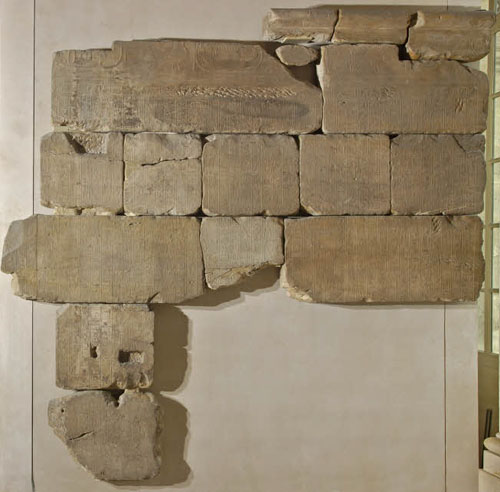Everyone makes them (some of us more compulsively than others): scribbled on post-it notes, or kept mentally in our imaginations we all make lists. And we’re not the only ones either; lists have been around for a long time possibly since the first writing systems and certainly since Sumerian scribes began to keep accounts in the fourth millennium BC in Mesopotamia. So what is it about the beauty of a list its numerical order, hierarchy, completeness that makes them such a part of how we like to categorise, order and understand the world?
An exhibition opening at the Louvre on 7 November may provide some insight into this intriguing subject, with its collection of lists ranging from some of the earliest known lists from Mesopotamian scribes, to modern hand-written lists from the Louvre archives. The name of the exhibition ‘Mille e Tre‘ (One thousand and three) is itself a reference to another famous list: it’s the number of Don Giovanni’s lovers in Mozart’s opera.
‘Mille e Tre‘ is part of a series of events and exhibitions at the Louvre called ‘The Vertigo of Lists‘, which is the brainchild of Italian writer and philosopher Umberto Eco. He is the latest personality to be invited to be ‘guest curator’ at the Louvre for one year and ‘The Vertigo of Lists‘ runs from 2 November to 13 December 2009.
The thinking behind this series of events is that vertigo, or dizziness, is what we feel when we are ‘faced with the impossibility of ordering our world’. Presumably Mr Eco isn’t just talking about making a shopping list here. Apparently lists also represent our need to ‘enumerate, to cite, to count, to classify, to record, to memorize’.
The exhibition Mille e Tre shows how lists have been around since antiquity: buried in tombs, naming gods or ancestors, commemorating athletes or treaties, and publicising the spoils of war. As well as a special exhibition area dedicated to Mille e Tre, other permanent exhibits at the Louvre will be specially sign-posted as part of the exhibition trail. Some of the older exhibits on display include:
A Sumerian Library Catalogue
A clay tablet dating from the start of the second millennium BC is actually a list of literary texts from a Sumerian library. It originates from Nippur (in ancient Mesopotamia, modern-day lower Iraq), which was one of the most important Sumerian cities.
An Inscribed Tablet
Mesopotamian literature was also applied to science and was used by scholars to catalogue types of plants and substances. This inscribed tablet in terracotta is an example.
The records of Thutmose III
The inscribed sandstone blocks from a wall at the Temple of Amun, Karnak, give a list of triumphs and booty brought back for the king during the reign of Thutmose III (1479-1425 BC).
The inscriptions reads: Account of booty in this town and among the troops of this miserable prince of the town of Tunip:
Prince of this town: 1
Soldiers: 3029
Silver: 100 dben (= 9 kg)
Gold: 100 dben (= 9 kg)
Lapis lazuli, turquoise and bronze vessels.
Further ancient lists can be found at the Louvre in rooms 5, 12 and 23 of the Department of Egyptian Antiquities and, in display case 16 of room 3 in the Department of Near Eastern Antiquities, in the Code of Hammurabi.
 These ancient tablets contrast with some of the modern lists on display, which include notes on the backs of drawings, in notebooks, and in the form of modern artworks and conceptual art.
These ancient tablets contrast with some of the modern lists on display, which include notes on the backs of drawings, in notebooks, and in the form of modern artworks and conceptual art.
According to the curator of Mille e Tre, Marie-Laure Bernadac, the list is a powerful and symbolic concept for modern artists and some of the modern pieces in the exhibition include wallpaper, a list of disappeared people and a book listing all the inhabitants of the Louvre. Called ‘Les Habitants du Louvre‘, the book lists all the people who currently work at the Louvre (about 2,000 people) as well as the 2,500 artists whose work is displayed there. It is on sale at the museum bookshop.
Umberto Eco is well known for his theories on semiotics and his novel The Name of the Rose. Past guest curators at the Louvre have included Robert Badinter (French criminal lawyer and anti-death penalty campaigner), US novelist Toni Morrison, Anselm Kiefer (a German painter and sculptor) and French classical music composer Pierre Boulez.
